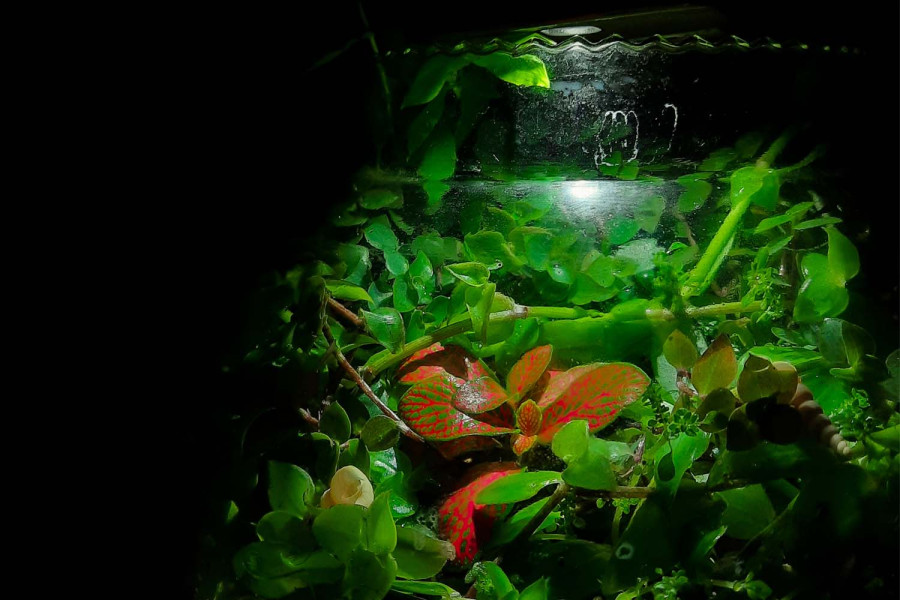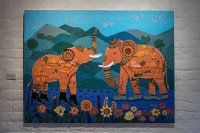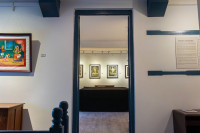Culture & Lifestyle
An enchanted microcosm of nature
Terrariums, a world inside of glass, show the beauty of nature’s resilience.
Samundra Gurung
Since the beginning, our attraction to nature has been innate—the desire to connect with our surroundings and explore, to touch and feel. Our senses are finely tuned to the world we inhabit. That’s why modern spaces, lacking the essence of nature, often feel sterile. To the mind, green symbolises the vast outdoors, offering a sense of life. Hence, we delicately strive to incorporate a piece of the outside into our living spaces.
Now, picture the expanse of nature condensed into a miniature realm—a microcosm brimming with life, a verdant sanctuary confined within glass boundaries. An object that invites one to pause and marvel at the wonders of nature meticulously crafted in a limited space. Such creations do exist and go by the name of terrariums. Originating from the Greek words ‘terra’, meaning earth, and ‘arium’, meaning place or container, this aptly describes these miniature landscapes enclosed within glass vessels, captivating the hearts of nature enthusiasts for centuries.
One of the oldest reported cases resembling a terrarium dates back to the nineteenth century, when Nathaniel Bagshaw Ward, a British physician and botanist, stumbled across the idea serendipitously. Ward, while placing a moth chrysalis in a sealed container, was astonished to find not only the moth emerging but also the spontaneous growth of plants—ferns and grasses—within the jar. This unplanned discovery sparked his curiosity, leading to further experiments with enclosed habitats.
His subsequent experiments involved sealing plants in glass cases, later known as ‘Wardian cases’. Originally designed for transporting plants overseas, these cases inadvertently became the precursors to modern terrariums. It is believed that Ward created the Wardian case to shield his ferns from the air pollution of 19th-century London. Eventually, these cases found a place in stylish drawing rooms across Western Europe and the United States, contributing to the popularity of the pteridomania Victorian fern craze, a term coined by author Charles Kingsley in 1855.
The fascination with exotic plant species and the desire to cultivate them in controlled environments fueled the interest in these glass-enclosed gardens. Terrariums evolved from Wardian cases into various forms and styles over time, transitioning from botanical marvel displays to instructional tools that teach about plant ecosystems, balance, and sustainability.
Creating a terrarium is similar to being an architect of a little planet, with each element carefully chosen to create an environment that mirrors nature's grandeur. It's a blank canvas ready for an artist's touch. The possibilities are as endless as one's imagination. A self-sustaining ecology exists within this glass-encased cosmos. Moisture flows throughout the plant, nourishing the flora and maintaining a delicate equilibrium. Plants breathe, soil keeps moisture, tiny insects like springtails and isopods help keep it free from mould by breaking down dead plant matter, and sunshine passes through the glass, regulating the light and temperature, creating a utopia that does not require human intervention to survive. The oldest sealed terrarium on record is claimed to be grown by David Latimer of England. It started in 1960, when he planted a single tradescantia cutting inside which was last opened in 1972, when he added a bit of water, then sealed again, never to be reopened.
Moving on to the types of terrariums, it is mainly categorised into two types: closed and open. The closed terrarium is the most classic (and interesting) kind. Sealing the terrarium and making it an enclosed system captures humidity and warmth and allows for the growth of fascinating tropical plants. The open type, however, may lose some of a traditional terrarium’s essential characteristics and features, but they’re ideal for plants that like drier climates and don’t need lots of water, like cacti and succulents.

The main principle of a functional terrarium is based on self-sustaining ecosystem and the recycling of nutrients. Externally, the only necessary input is light. This is the source of energy required for survival and growth. Light reflects off the leaves and is absorbed by chlorophyll-containing proteins in the plant. Plants store a small amount of light with ATP (adenosine triphosphate) to provide energy. The plant’s roots utilise the rest to remove electrons in water. The electrons are then free to release oxygen when carbon dioxide is converted into carbohydrates through chemical processes. Cellular respiration decomposes organic substances in the environment, such as dead leaves. This is done by bacteria, which absorb extra oxygen, emit carbon dioxide, and aid in plant growth. Plants employ the same cellular respiration mechanism to break down chemicals stored in the absence of light (at night). Water circulates throughout the plant, being trapped in its roots, escaping into the atmosphere, and condensing in the potting mix. The cycle starts over and continues to repeat itself.
Offering glimpses into the complex web of nature’s interactions. Terrariums teach us about the delicate balance of ecosystems, the interdependence of living organisms, and the resilience of life in confined spaces, helping to serve as educational tools as well. This intricate soirée of catering to their needs makes tending to a terrarium a mindful and rewarding experience. Furthermore, these small gardens provide a welcome break from the rush and bustle of modern life. When placed on desks, bookcases, or coffee tables, they add a touch of greenery to urban environments, serving as peaceful havens amidst concrete jungles. Their presence promotes relaxation, awareness, and connection with nature. In a world where time seems fleeting, space as luxury and the scale of nature overwhelming, terrariums invite us to embrace the small, the intricate, and the delicate. They encapsulate the essence of nature's grandeur in a confined space, urging us to marvel at the wonders that thrive within these glass-enclosed worlds.
So, the next time you see a terrarium, take a moment to explore, immerse yourself in its beauty, admire the complex balance of life it supports, and allow yourself to be enchanted by the magic and resilience of nature, for at that moment you may just find yourself transported in a world where small is mighty and confined is boundless.




 8.12°C Kathmandu
8.12°C Kathmandu















